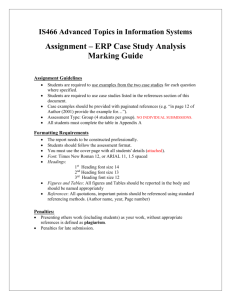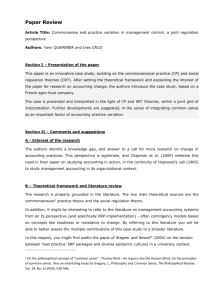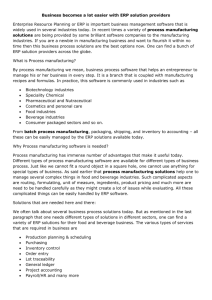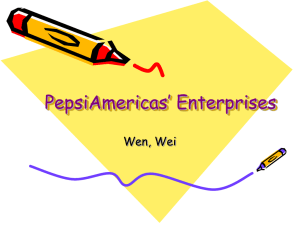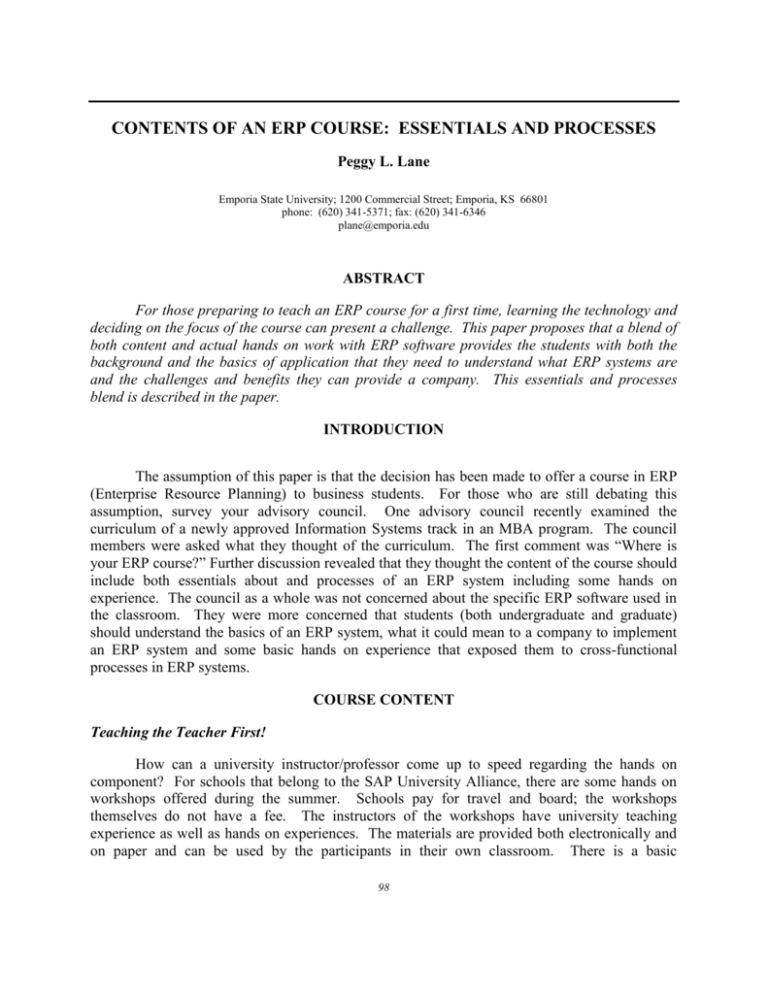
CONTENTS OF AN ERP COURSE: ESSENTIALS AND PROCESSES
Peggy L. Lane
Emporia State University; 1200 Commercial Street; Emporia, KS 66801
phone: (620) 341-5371; fax: (620) 341-6346
plane@emporia.edu
ABSTRACT
For those preparing to teach an ERP course for a first time, learning the technology and
deciding on the focus of the course can present a challenge. This paper proposes that a blend of
both content and actual hands on work with ERP software provides the students with both the
background and the basics of application that they need to understand what ERP systems are
and the challenges and benefits they can provide a company. This essentials and processes
blend is described in the paper.
INTRODUCTION
The assumption of this paper is that the decision has been made to offer a course in ERP
(Enterprise Resource Planning) to business students. For those who are still debating this
assumption, survey your advisory council. One advisory council recently examined the
curriculum of a newly approved Information Systems track in an MBA program. The council
members were asked what they thought of the curriculum. The first comment was “Where is
your ERP course?” Further discussion revealed that they thought the content of the course should
include both essentials about and processes of an ERP system including some hands on
experience. The council as a whole was not concerned about the specific ERP software used in
the classroom. They were more concerned that students (both undergraduate and graduate)
should understand the basics of an ERP system, what it could mean to a company to implement
an ERP system and some basic hands on experience that exposed them to cross-functional
processes in ERP systems.
COURSE CONTENT
Teaching the Teacher First!
How can a university instructor/professor come up to speed regarding the hands on
component? For schools that belong to the SAP University Alliance, there are some hands on
workshops offered during the summer. Schools pay for travel and board; the workshops
themselves do not have a fee. The instructors of the workshops have university teaching
experience as well as hands on experiences. The materials are provided both electronically and
on paper and can be used by the participants in their own classroom. There is a basic
98
introduction workshop that can be followed by the Business Process Integration (BPI) workshops
(BPI –I and BPI-II). There is also a follow up workshop entitled SAP Cases in the Classroom.
There are additional workshops that focus on other aspects of SAP. A side benefit of the
workshops is meeting and exchanging contact information with other university
instructors/professors who are also learning and will be teaching SAP.
If your university does not belong to the SAP University Alliance, there are other options.
The author of this paper moved from a university with SAP to one that does not belong to the
SAP University Alliance. Microsoft Great Plains was not too hard to figure out and use in the
classroom. Some text books (Brunsdon, Romney and Steinbart) come with an older version of
Great Plains that the students can load on their own computers.
Essentials With Articles
Regardless of the software used, the course content should be a blend of information
about ERP and hands on experience. Beginning with an ERP overview is a great way to begin
the course. There are many book chapters or articles that could be used. One article that
continues to be updated and has become a tutorial is by Christopher Koch (Koch, 2007). So that
the students can understand the background of ERP, it is helpful to follow the ERP overview
with a history of ERP. Chapter 2 of Monk and Wagner (2006) provides such a history.
Including the technology behind the ERP system is not essential, but provides the students
(information systems as well as other majors) with a look into how the software works.
Whiting (2006) provides an overview of the three most influential vendors (SAP, Oracle,
and Microsoft) in the ERP software industry and includes their future plans. Students can be
given an assignment that requires them to discuss the similarities and differences among the
three vendors on factors such as companies acquired, products currently supporting, technical
details, future plans, and future risks. There is also a web site that lists the different vendors and
the top vendors in different areas: http://www.2020software.com/ One possible assignment
could require the students to obtain a free demo and make a presentation to the class about it.
Processes With Software
After the foundation has been presented, students are ready for their first hands on
experience with SAP software. The first lesson usually includes navigation, some basic setup,
and how to run reports. Running reports helps students understand the end result and gives them
an anchor as they learn more of the details in future class sessions. Instructors should make sure
they have worked with the software in the room in which they are presenting and are very
comfortable with it.
The next step taken depends on the instructor. Some will cover additional features of
setup in the ERP software. This approach allows the instructor to refer back to these features in
future lessons. Another way to attack the material is to dive into the software as a user. Students
seem more interested in this approach and seem to understand the idea of integrated data faster
with this approach. The sales process is a good place to start. They can begin the process by
99
entering a new material for sale in the system. The sales process incorporates the sales
department, checking of inventory, shipping the goods, and the accounting department in the
billing and receiving of payment. As they perform each step, they should be aware of which
business function they are performing and that in a company one person will not perform all of
the steps they are performing. Reports can be run so that they can see the results of their sales
and the automatic journal entries created. They should be aware of when each of the entries was
created. After the sales order process is mastered, the purchasing process can be covered.
Similarities in the processes can be explored – instead of selling to customers, they are
purchasing from vendors; instead of removing inventory, they are adding to inventory; instead of
receiving payment, they are making a payment. As both the sales order process and purchasing
process are explained, the automatic journal entries made by the system should be examined
through reports or queries.
After the sales and purchasing processes have been covered, the manufacturing process
can be presented. They can start with a sales order for which there is not enough inventory in
stock. This will lead to a manufacturing requisition. This will require inventory of raw
materials. However, if there is not enough of all raw materials in inventory, then the students
will have to use the purchasing process to procure raw materials. The manufacturing and sales
processes can then be completed.
To reinforce the three processes, a project can be assigned. The project will require the
students to use all three processes for a different company. The project should include a business
decision such as a make or buy decision to help them understand how the software can make a
difference in the life of a company.
Additional Essential Topics
As students are learning the ERP software, other topics should be covered with articles,
books, and guest speakers. Some of the topics that can be included are reengineering, RFID,
change management, implementation, failed implementation, Sarbanes-Oxley, business process
improvement, and the value ERP systems bring to an organization. If the university is currently
going through or has recently completed an ERP implementation, consider inviting the project
manager to your class for a presentation and a time for questions and answers. Ideas for
additional assignments include assigning a paper to further investigate a topic of interest to the
students and a case study. Although the Nibco case (Brown and Vessey, 2001) is from 2001, it
is still a good case to use and lends itself to a great discussion on change management.
SUMMARY
This paper has attempted to describe the contents of a first ERP course that could be
taught at either the undergraduate or graduate level. The course should include both essentials
about ERP and processes of an ERP system including some hands on experience that exposes
students to cross-functional processes in ERP systems. Through discussing articles and readings
and experiencing ERP software hands on, at the end of the course, students should be able to
100
participate in conversations (including interviews) about what ERP software is, its advantages,
its disadvantages and some pitfalls to avoid when implementing ERP software.
101
REFERENCES
Brown, C. and Vessey, I. (2001). Nibco’s Big Bang. Communications of AIS, 5(1), 1-42.
Brunsdon, T, Romney, M., and Steinbart, P. (2006) Introduction to Microsoft Great Plains 8.0: Focus on Internal
Controls, New Jersey: Pearson Prentice Hall.
Koch, C. (2007) ABC: An Introduction to ERP (Getting started with Enterprise Resource Planning (ERP).
http://www.cio.com/article/40323/ABC_An_Introduction_to_ERP/1
Monk, E. and Wagner, B. (2006). Concepts in Enterprise Resource Planning, 2nd edition, Boston: Thomson Course
Technology.
Whiting, R. (2006). ERP Gets a Complete Makeover. Information Week .July 24, 2006, 32-39.
102





